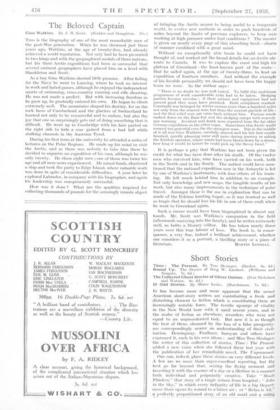The Beloved Captain
Tins is the biography of one of the most remarkable men of the post-War generation. - When he was drowned just three years ago, Watkins, at the age of twenty-five, had. already achieved a world reputation. Not only had he been presented to two kings and with the geographical medals of three nations, but his three Arctic expeditions had been so successful that several eminent geographers have placed him on a level with Shackleton and Scott.
As a boy Gino Watkins showed little promise. After failing for the Navy he went to Lancing, where he took no interest in work and hated games, although lie enjoyed the independent sports of swimming, cross-country running and rifle shooting. He was not made a prefect. But with increasing freedom as he grew up, he gradually entered)iis own. He began to climb extremely well. The mountains shaped his destiny, for on the rock faces of Cumberland and the glaciers of Switzerland he learned not only to be resourceful and to endure, but also the joy that one so surprisingly gets out of doing something that is difficult.' He went up to Cambridge with his hair parted on the right side to hide a scar gained from a bad fall while stalking chamois in the Austrian Tyrol.
During his first term at the university he attended a series of lectures on the Polar Regions. He made up his mind to visit the Arctic, and as there was nobody to take, him there he decided to organize an expedition of his own, although lie was only twenty. He chose eight men ; one of them was twice his age and all were more experienced. He raised funds, chartered a ship and took the party to Edge Island, where valuable work was done in spite of considerable difficulties. A year later he explored Labrador, in company with his biographer, and again his leadership was conspicuously successful.
How was it done ? What are the qualities required for collecting thousands of pounds for the seemingly remote object .of ,bringing the Arctic nearer to being useful.to a temperate world, to evolve new methods in order to push hundreds of
miles beyond the limits of previous explorers, to keep men working at high pressure under foil conditions ? The answer
is given on nearly every page of this absorbing book—charm of manner combined with a great mind.
Without an exceptionally able brain lie could not have thought of, and worked out the broad details for, an Arctic air- route to Canada. It was to explore the coast and high ice plateau of Greenland—the least-known part of the route— that he sailed again, at the age of twenty-three, to lead an expedition of fourteen members. And without the example
of his lovable personality we should not have been the happy team we were. As theauthor says :
" There is no doubt he was well tested. To fulfil this ambitious programme of work considerable risks had to be taken. Sledging parties became overdue ' • if their rations and equipment had not proved good they must have perished. Both aeroplanes crashed. Courtauld was besieged by winter storms more than a hundred miles not only from the nearest man but from the nearest particle of life ; and the first relief sent out came back without him. Furious winds rushed down on the Base hut and the sledging camps with scarcely any warning. Accident and death wore reported from the far older German expedition on the other coast. Sometimes this Arctic world seemed too powerful even for the strongest man. But in the middle of it all was Gino Watkins, carefully shaved and his fair hair neatly brushed, quietly planning some still more daring journey or asking the ivireless operator, whose masts had been blown down by a storm, how long it would bo before he could pick up the Savoy band."
• It is perhaps a pity that Watkins has not been given the credit for what has been done after his death. Of the twelve men who survived him, nine have carried on his work, both in the North and in the South. The author could have men- tioned that the national expedition now in the Antarctic is led by one of Watkins's lieutenants, with four others of his train- ing. He left much behind him in addition to an example.
Not only knowledge and new maps, the tangible results of his work, but also many improvements in the technique of polar
travel. Amongst these is the use in exploration that can be made of the Eskimo hunting kayak, so it was ironical as well
as tragic that he should lose his life in one of these craft when he went to Greenland again.
Such a career would have been biographical in almost any hands. Mr. Scott was Watkins's companion in the field (afterwards marrying into the family), and he writes extremely well, as befits a literary editor. He has taken nearly three years over this true labour of love. The book is, in conse- quence, a very fine, indeed a brilliant achievement, whether one considers it as a portrait, a thrilling story or a piece of














































 Previous page
Previous page